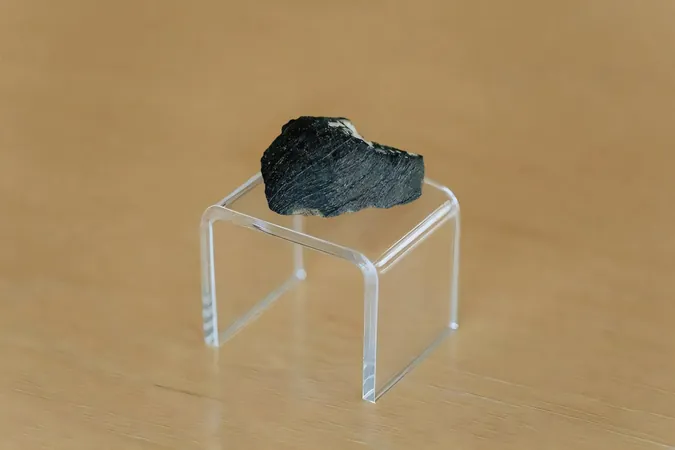
Groundbreaking Discovery: Ancient Liquid Water on Mars Identified via Meteorite Analysis
2024-11-13
Author: Sophie
Groundbreaking Discovery: Ancient Liquid Water on Mars Identified via Meteorite Analysis
In a remarkable turn of events, scientists have confirmed the presence of liquid water on Mars approximately 742 million years ago, uniquely tied to the Lafayette Meteorite—an extraterrestrial fragment that journeyed from the Red Planet to Earth. This meteorite, ejected from Mars by an asteroid collision around 11 million years ago, eventually landed near Purdue University, where it was serendipitously rediscovered in a drawer in 1931.
Recent investigations led by an international team of scientists, including notable researchers from Purdue University, have provided compelling evidence that the minerals found within the Lafayette Meteorite were formed in the presence of liquid water. This discovery holds profound implications for understanding Mars' geological history and its potential for sustaining life.
Marissa Tremblay, an assistant professor in the Department of Earth, Atmospheric, and Planetary Sciences at Purdue, spearheaded the study published in Geochemical Perspective Letters. Utilizing noble gases—helium, neon, and argon—Tremblay explained how these elements helped date the minerals formed during the meteorite's time on Mars. "Our dating revealed that liquid water interacted with the meteorite during a time when abundant surface water was not present. Instead, we attribute the water's presence to the melting of subsurface ice, likely caused by magmatic activity on Mars," she elaborated.
The research team demonstrated the reliability of their findings by ensuring that external factors—like the meteorite's ejection from Mars, its journey through space, and its fiery descent into Earth's atmosphere—did not distort the age estimation of the aqueous alteration within the meteorite.
Co-author Ryan Ickert, a senior research scientist, emphasized the uniqueness of the Lafayette Meteorite, stating, "This meteorite provides unprecedented evidence of water interaction, and our publication clarifies the timing of this significant event."
The Lafayette Meteorite's journey doesn't end with its impact on Earth—it also holds a mysterious narrative. While it arrived on our planet more than nine decades ago, the circumstances of its acquisition by Purdue University remain unclear. Tremblay's team has attempted to unravel this mystery by analyzing organic contaminants found on the meteorite that are indicative of specific crop diseases prevalent in certain years, potentially pinpointing the year of its fall.
Meteorites like Lafayette serve as celestial time capsules, offering invaluable insights into the history of planets and asteroids. Their unique mineral compositions and isotopes set them apart from terrestrial rocks, allowing scientists to trace their origins back to their parent celestial bodies.
Tremblay remarked, "By studying the minerals and their relationships within the meteorite, we can identify its source and its history. The chemistry of meteorites reveals clues that help us understand planetary processes and the potential for water, which is vital for life."
This collaborative research effort involved experts from several esteemed institutions, demonstrating a unified endeavor to deepen our understanding of planetary science. As scientists continue to explore the geochemistry of meteorites, including the Lafayette piece, future studies may reveal even more secrets of Mars and its ancient environment.









 Brasil (PT)
Brasil (PT)
 Canada (EN)
Canada (EN)
 Chile (ES)
Chile (ES)
 Česko (CS)
Česko (CS)
 대한민국 (KO)
대한민국 (KO)
 España (ES)
España (ES)
 France (FR)
France (FR)
 Hong Kong (EN)
Hong Kong (EN)
 Italia (IT)
Italia (IT)
 日本 (JA)
日本 (JA)
 Magyarország (HU)
Magyarország (HU)
 Norge (NO)
Norge (NO)
 Polska (PL)
Polska (PL)
 Schweiz (DE)
Schweiz (DE)
 Singapore (EN)
Singapore (EN)
 Sverige (SV)
Sverige (SV)
 Suomi (FI)
Suomi (FI)
 Türkiye (TR)
Türkiye (TR)
 الإمارات العربية المتحدة (AR)
الإمارات العربية المتحدة (AR)